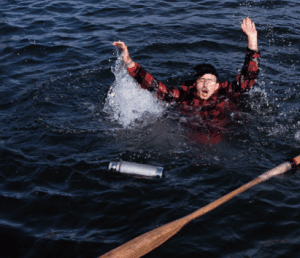Emergency: Cold Water Immersion
 Capsizing and falling overboard into cold water (water temperature below 15°C) account for a high number of boating fatalities. Cold water can paralyze your muscles instantly.
Capsizing and falling overboard into cold water (water temperature below 15°C) account for a high number of boating fatalities. Cold water can paralyze your muscles instantly.
Always ensure :
- Everyone on board is wearing a lifejacket or PFD, especially if boating in cold waters below 15°C;
- You have a functioning communication device on board;
- You are aware of situations that might lead to falling overboard to prevent them from happening (reaching overboard and improper loading).
Boaters’ risk of dying increases with cold water temperatures, especially sports enthusiasts who hunt and fish from boats in cold weather. Exposure to low temperatures (such as cold water immersion or prolonged exposure to cold weather) will lead to hypothermia.
Hypothermia is a drop in core body temperature below the normal level. It weakens a person’s muscles, reduces coordination, and slows mental functions. Hypothermia can lead to death.
Phases of Cold Water Immersion
1-10-1 is a simple way to remember the first three phases of cold water immersion and the approximate time each phase takes.
- 1 Minute: Cold Water Shock – An initial deep and sudden gasp, followed by hyperventilation, muscle spasms and significant changes in heart rate and blood pressure.
- 10 Minute: Cold Incapacitation – Over approximately the next 10 minutes, you will lose the effective use of your fingers, arms and legs for any meaningful movement. This will make it very difficult to swim (even for strong swimmers).The longer you remain in cold water, the harder it is to coordinate your movements.
- 1 Hour: Hypothermia – Your body’s temperature dips below 36 degrees Celsius, and you will experience weak, irregular or absent pulse or respiration. In the final stage, the victim will lose consciousness. Even in ice water it could take approximately 1 hour before becoming unconscious.

